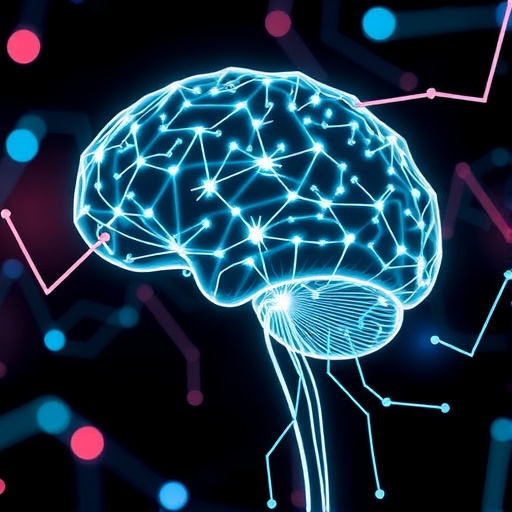Revolutionizing Depression Treatment: Unraveling the Neural Dynamics of Repetitive Transcranial Magnetic Stimulation through Advanced Causal Modeling
In a groundbreaking study poised to reshape the understanding and clinical application of brain stimulation therapies, researchers have delved deep into the neural circuitry underlying major depressive disorder (MDD) using innovative computational techniques alongside repetitive transcranial magnetic stimulation (rTMS). This multifaceted exploration transcends conventional neurological assessments, harnessing dynamic causal modeling (DCM) to map precise alterations in brain network connectivity elicited by rTMS, thus illuminating the intricate mechanisms by which this non-invasive intervention mitigates depressive symptoms.
Major depressive disorder, a debilitating and widespread psychiatric condition, afflicts millions globally, with many patients exhibiting resistance to pharmacological and psychotherapeutic approaches. rTMS has emerged as a promising neuromodulation technique, capable of modulating cortical activity through targeted magnetic pulses. However, despite its expanding clinical use, the detailed network-level effects remain enigmatic, primarily due to the complexity of brain connectivity and the limitations of traditional neuroimaging analyses. This study addresses these gaps by integrating sophisticated causal models to decipher directional interactions among neural populations, marking a pivotal step toward precision psychiatry.
Dynamic causal modeling provides a computational framework that infers the strength and directionality of connectivity between brain regions based on neuroimaging data, often functional MRI or EEG. Unlike correlational methods, DCM illuminates how activity in one region causally influences another in response to external perturbations, such as rTMS. By applying DCM systematically before and after rTMS treatment sessions, the researchers have generated nuanced insights into adaptive neuroplastic changes, highlighting pathways critical to emotional regulation and mood stabilization disrupted in depression.
The investigative team targeted the dorsolateral prefrontal cortex (DLPFC), a brain region consistently implicated in mood regulation and often selected as the stimulation site during rTMS therapy for depression. Through longitudinal imaging and model-based analyses, shifts in effective connectivity between the DLPFC and key subcortical structures, particularly the anterior cingulate cortex (ACC) and amygdala, were observed. These findings underscore a rebalancing of top-down control circuits disrupted in depressive neurobiology, potentially explaining symptom amelioration observed clinically.
Importantly, the study clarifies how repetitive magnetic stimulation modulates intrinsic inhibition-excitation dynamics within these networks. By enhancing DLPFC’s regulatory influence over limbic regions, rTMS appears to restore the functional hierarchy necessary for adaptive emotional processing. This mechanistic understanding transcends descriptive statistics, providing a causal narrative linking interregional connectivity changes to therapeutic outcomes, thereby informing optimal stimulation parameters and treatment personalization.
Moreover, the application of DCM allowed for the differentiation of responders and non-responders to rTMS therapy at a neural circuit level. The capacity to delineate distinct patterns of effective connectivity modulation introduces a potential biomarker avenue, facilitating early identification of patients likely to benefit from rTMS, optimizing resource allocation, and minimizing trial-and-error in treatment regimens. This stratification marks a significant advance toward tailored interventions in psychiatry.
The ramifications of this research extend beyond depression, touching upon broader neuropsychiatric conditions characterized by dysregulated neural networks. The methodological integration exemplified here sets a precedent for mechanistic investigations of brain stimulation techniques across disorders such as anxiety, obsessive-compulsive disorder, and schizophrenia, wherein fronto-limbic dysconnectivity similarly plays a pivotal role.
Notably, the temporal resolution of the imaging modalities combined with DCM’s capacity for inferring directed interactions enables a dynamic portrayal of network reconfiguration. This temporal dimension is crucial for understanding plasticity processes and informing the timing and frequency of stimulation pulses to maximize therapeutic efficacy. Such insights prompt reevaluation of current clinical protocols, potentially leading to more refined, adaptive rTMS regimens.
The study also addresses prior controversies surrounding the variability of rTMS outcomes by elucidating the neural mechanisms underpinning heterogeneity in response. By dissecting causal influences rather than mere correlations, it highlights how individual differences in baseline connectivity profiles might guide treatment customization. This personalized approach aligns with the burgeoning field of computational psychiatry, merging neurobiology and algorithm-driven analytics.
From a technical standpoint, the robust application of dynamic causal modeling necessitated rigorous data preprocessing and model validation. Researchers incorporated Bayesian model selection techniques to identify the best-fitting connectivity architecture for each subject, ensuring that the inferred neural interactions accurately reflect underlying physiology. Such methodological rigor bolsters confidence in the translational relevance of the findings.
Furthermore, these results advocate for integrating neuroimaging biomarkers into clinical workflows, enabling clinicians to monitor treatment-induced neurophysiological changes in near real-time. This feedback loop could facilitate adaptive modulation strategies, where stimulation parameters are dynamically adjusted in response to neural network signatures, ushering in a new paradigm of closed-loop neuromodulation.
While promising, the authors acknowledge limitations inherent to the study design, including sample size and the generalizability of findings across diverse depressive phenotypes. Future research employing larger cohorts with multimodal imaging and expanded follow-up durations will be essential to consolidate these insights and translate them into standardized clinical guidelines.
In summary, this seminal work leverages the power of dynamic causal modeling to unravel the sophisticated neural mechanisms engaged by repetitive transcranial magnetic stimulation in major depressive disorder, transcending correlative observations and offering a causal framework that may revolutionize personalized neuromodulatory therapies. As the global burden of depression escalates, such mechanistic clarity fuels hope for more effective, targeted, and adaptable interventions, promising improved quality of life for millions.
As neuroscience strides confidently into the era of precision medicine, this integration of advanced computational modeling with clinical neuromodulation exemplifies the synergy necessary to unlock the brain’s complexity. Future explorations may build on these foundations to unravel multifactorial brain disorders further, fostering innovation at the intersection of technology and mental health care.
Subject of Research: Major Depressive Disorder and the neural mechanisms underlying repetitive transcranial magnetic stimulation therapy.
Article Title: Exploring the capabilities of repetitive transcranial magnetic stimulation in major depressive disorder: Dynamic causal modeling of the neural network.
Article References:
Kita, A., Ishida, T., Kita, N. et al. Exploring the capabilities of repetitive transcranial magnetic stimulation in major depressive disorder: Dynamic causal modeling of the neural network. Transl Psychiatry 15, 257 (2025). https://doi.org/10.1038/s41398-025-03480-7
Image Credits: AI Generated




